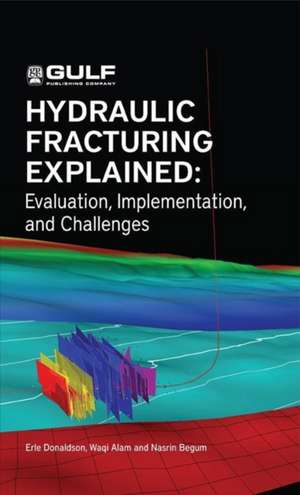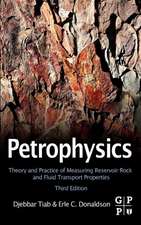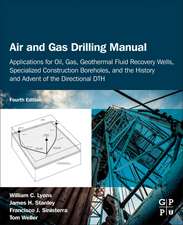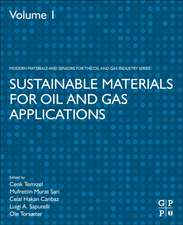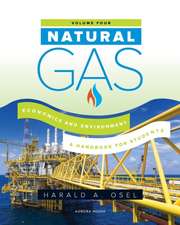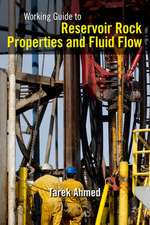Hydraulic Fracturing Explained: Evaluation, Implementation, and Challenges
Autor Erle C. Donaldson, Waqi Alam, Nasrin Begumen Limba Engleză Hardback – 31 mar 2013
Preț: 784.62 lei
Preț vechi: 1144.66 lei
-31% Nou
Puncte Express: 1177
Preț estimativ în valută:
150.18€ • 163.19$ • 126.24£
150.18€ • 163.19$ • 126.24£
Carte tipărită la comandă
Livrare economică 14-28 aprilie
Preluare comenzi: 021 569.72.76
Specificații
ISBN-13: 9781933762401
ISBN-10: 1933762403
Pagini: 224
Dimensiuni: 156 x 234 x 18 mm
Greutate: 0.48 kg
Editura: ELSEVIER SCIENCE
ISBN-10: 1933762403
Pagini: 224
Dimensiuni: 156 x 234 x 18 mm
Greutate: 0.48 kg
Editura: ELSEVIER SCIENCE
Cuprins
- Dedication
- Foreword
- Preface
- Acknowledgments
- List of Figures
- List of Tables
- Nomenclature
- Acronyms/Abbreviations
- Symbols
- Greek Letters
- CHAPTER 1. Hydraulic Fracturing Explained
- 1.1 Introduction
- 1.2 Petroleum Hydrocarbons
- 1.3 Petroleum Reserves in Shale
- 1.4 Petroleum Demand
- 1.5 Achieving Production of Hydrocarbons to Meet Demand
- 1.6 Hydraulic Fracturing
- 1.7 Environmental Issues Related to Hydraulic Fracturing
- CHAPTER 2. Evaluation of Gas-Shale Formations
- 2.1 Sedimentary Formations
- 2.2 Shale Formations
- 2.3 Multistage Fractures
- 2.4 Fracture Design (Frac-Implementation)
- 2.5 Well Design from Surface to Reservoir
- 2.6 Gas-Shale Reservoir Characterization
- 2.7 Gamma-Ray Well-Log
- 2.8 Density/Neutron Log
- 2.9 Use of Seismic Data
- CHAPTER 3. Rock Mechanics of Fracturing
- 3.1 Introduction
- 3.2 Young's Modulus of Elasticity (E)
- 3.3 Poisson's Ratio (v)
- 3.4 Bulk Modulus (KB)
- 3.5 Shear Modulus (G)
- 3.6 Effective Stress
- 3.7 Mohr Stress Diagram
- 3.8 Initiation of Fractures
- 3.9 Propping the Fracture Open
- CHAPTER 4. Fracture Fluids
- 4.1 Introduction
- 4.2 Oil-Based Fracturing Fluids
- 4.3 Water-Based Frac-Fluids
- 4.4 Alcohol-based Frac-fluids
- 4.5 Acid Frac-Fluid
- 4.6 Foams
- 4.7 “Slick-Water
- 4.8 Surfactants
- 4.9 Clay Stabilizers
- 4.10 Temperature Stabilizers
- 4.11 Fluid-Loss Additives
- 4.12 Viscosity Breakers
- 4.13 Biocides
- 4.14 Buffers
- 4.15 Frac-Fluid Preparation
- 4.16 Conclusion
- CHAPTER 5. Field Implementation of Hydraulic Fracturing
- 5.1 Introduction
- 5.2 Protecting Groundwater
- 5.3 Waste Water Management in Hydraulic Fracture
- 5.4 Fresh Water Management in Hydraulic Fracturing
- 5.5 Reducing Surface Disturbance
- 5.6 Controlling Noise, Lighting, and Traffic at Fracturing Job Sites
- 5.7 Technical Considerations for the Success of Hydraulic Fracture Treatments
- 5.8 Case Studies of Hydraulic Fracturing
- CHAPTER 6. Environmental Impacts of Hydraulic Fracturing
- 6.1 Surface and Subsurface Environmental Effects
- 6.2 Water Withdrawals
- 6.3 Surface Spills
- 6.4 Wastewater Management
- 6.5 Air Emissions
- 6.6 Water Impoundments
- 6.7 Human Health Impacts
- 6.8 Where to Get Toxicity Information
- 6.9 Chemicals Present In Hydraulic Fracturing Fluid
- 6.10 Chemicals Present in Flow-Back Fluids
- 6.11 Regulations for Protecting the Environment
- 6.12 Regulations Currently Applicable
- APPENDIX A. Viscosity
- A.1 Power-Law Fluids
- APPENDIX B. Surfactants, Emulsions, Gels, Foams
- B.1 Surfactants
- B.2 Emulsions
- B.3 Foams
- APPENDIX C. Calculations
- C.1 Subsurface Overburden and Horizontal Stress
- C.2 Fracture Initiation Pressure
- C.3 Fracture Propagation Pressure
- C.4 Matrix Permeability
- C.5 Fracture Size
- C.6 Rock Matrix Mechanical Properties
- C.7 Summary
- Glossary
- References
- Index
